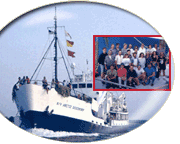

|
 |


How was the
enormous treasure recovered at depths of 8000 feet?
What is the
treasure worth?
What was gold
worth in 1857?
What would one of
the assayer ingots actually buy in 1857?
What is the
largest assayer ingot previously known to exist?
Why
didn’t large private assayer ingots survive?
Shouldn’t the
treasure be in a museum?
How were the
efforts of Captain Herndon perceived?
Where can I find a DVD
copy of the History Channel program "Ship of Gold?"
How much did
Warner Brothers pay for the movie rights to "Ship of
Gold?"
How can I acquire a
piece of this historic treasure?
(If you have questions we haven't answered,
please email
us.)
How was
the enormous treasure recovered at depths of 8000
feet?
The Washington Post’s September 14, 1989, article
titled, "Storybook Treasure Found off South Carolina"
stated, "Thompson and company . . . set out to do what
never had been done before . . . not only to find the
Central America but to excavate it with archaeological
precision on the deep ocean floor using only undersea
robotics. Nemo, their 12,000-pound, remotely operated
exploration vehicle, has the capacity of recovering items
as large as a 1,000 pound anchor or as small as a
dime."
[ Back to top ]
What
is the treasure worth?
Excluding the personal and nautical historic artifacts, the
treasure trove of gold coins, ingots and miner’s dust
should be placed in private collections for as much as $200
million.
[ Back to top ]
What
was gold worth in 1857?
During the California Gold Rush era of the 1850s, the
United States Dollar was fixed to gold at the rate of
$20.67 per pure troy ounce.
[ Back to top ]
What
would one of the assayer ingots actually buy in
1857?
In the California gold fields, a day’s wages was $5.
Most of the ingots have a currency value of over $1,000,
representing almost a year’s wages in the highly
inflated California economy. The price of steerage
accommodations on the SS Central America was $150.
First-cabin accommodations were $300, which was quite a sum
in those days.
[ Back to top ]
What
is the largest assayer ingot previously known to
exist?
The most renowned numismatic reference guide, the Red Book,
documents eight specimens that range in weight from 1.5 to
2.5 ounces. The Red Book also records the auction sale of a
2.5-ounce F. D. Kohler ingot (stamped with a $50 currency
value) from the Norweb collection for $200,000 in 1989. The
Smithsonian Institution received specimens from the famed
Ford collection, the largest of which is about 2 ounces --
a fraction of the Central America’s prized "Eureka"
bar, which weighs 933 ounces. The Eureka bar is stamped
with the 1857 currency value of $17,433.57.
[ Back to top ]
Why didn’t large private assayer ingots
survive?
Considering that private assayer coins survived in great
quantity and are highly prized by collectors, it is amazing
that very few specimens, all quite small, of the assayer
ingots are still in existence. Although the assayer ingots
were accepted in transactions, many of the private coins
and ingots were refined and used to make new United States
coinage, once the US mints were able to meet demand.
Obviously, small private coins were preferred and hoarded,
unlike the larger, inconsistent forms of money, such as
ingots.
[ Back to top ]
Shouldn’t the treasure be in a
museum?
Many American’s feel that the entire treasure should
be in a museum. They are correct that each piece is so rare
and historically important that it warrants that level of
appreciation and conservation. Fortunately, many investors
and collectors do consider giving their family heirlooms to
museums to be preserved for posterity.
[ Back to top ]
How were
the efforts of Captain Herndon perceived?
Not only was the Herndon Monument erected in 1860 at the
United States Naval Academy in Annapolis, but as Frank
Leslie’s Illustrated Newspaper wrote in 1857, "There
cannot be a doubt about the fact that the name of Captain
Herndon will ever be held in grateful remembrance among all
the heroes who have achieved triumphs upon the sea."
[ Back to top ]
[ Back to top ]
Where can I
find a DVD copy of the History Channel program "Ship of
Gold"
The History Channel has sold DVD copies of the program
"Ship of Gold" online. Also, Monaco Financial, an
Authorized Ingot Dealer, makes the video available to those
who are interested. You may call 888-900-9948 for
details.
[ Back to top ]
How much
did Warner Brothers pay for the movie rights to "Ship of
Gold"
The highly regarded rare coin periodical, The Numismatist,
reported that a sum of $800,000 was paid by Warner Brothers
to acquire the movie rights to the best seller, "Ship of
Gold."
[ Back to top ]
How can I
acquire a piece of this historic treasure?
There is a rare and important opportunity to acquire
artifacts from this historic treasure at the moment.
Consider calling an Authorized Ingot Dealer for details.
You may call Monaco Financial, the primary ingot dealer,
toll free at 888-900-9948.
[ Back to top ]
(If you have questions we haven't answered,
please email
us.)
© Copyright 2016
ShipofGold.com
All rights reserved
Contact Us
|




